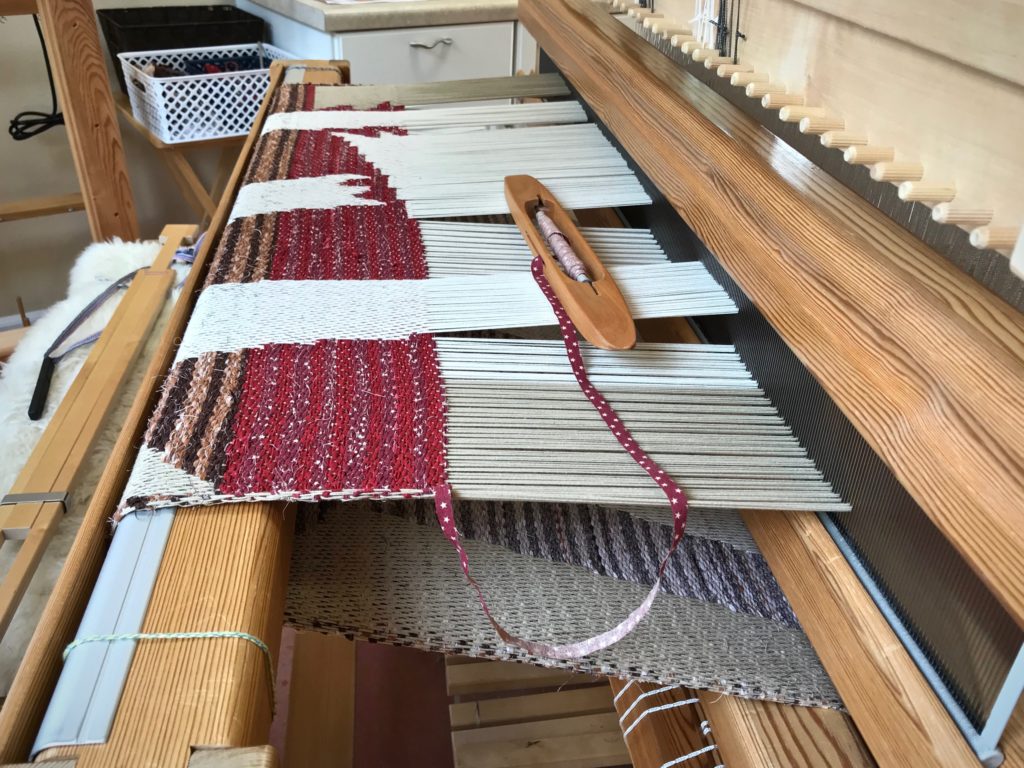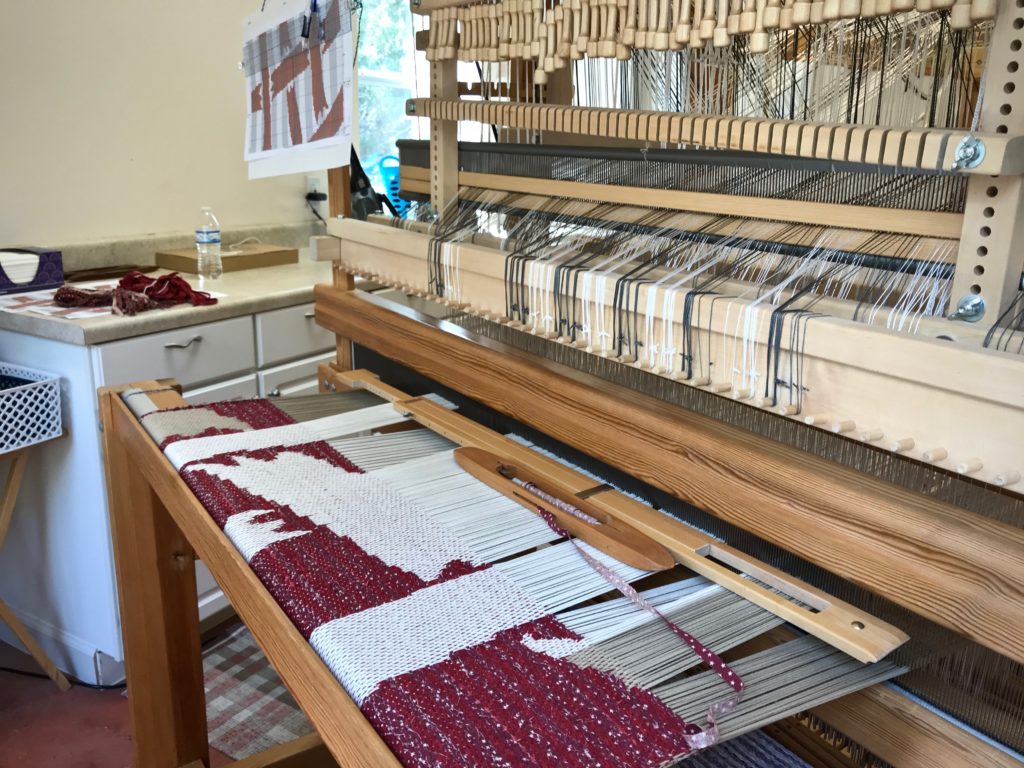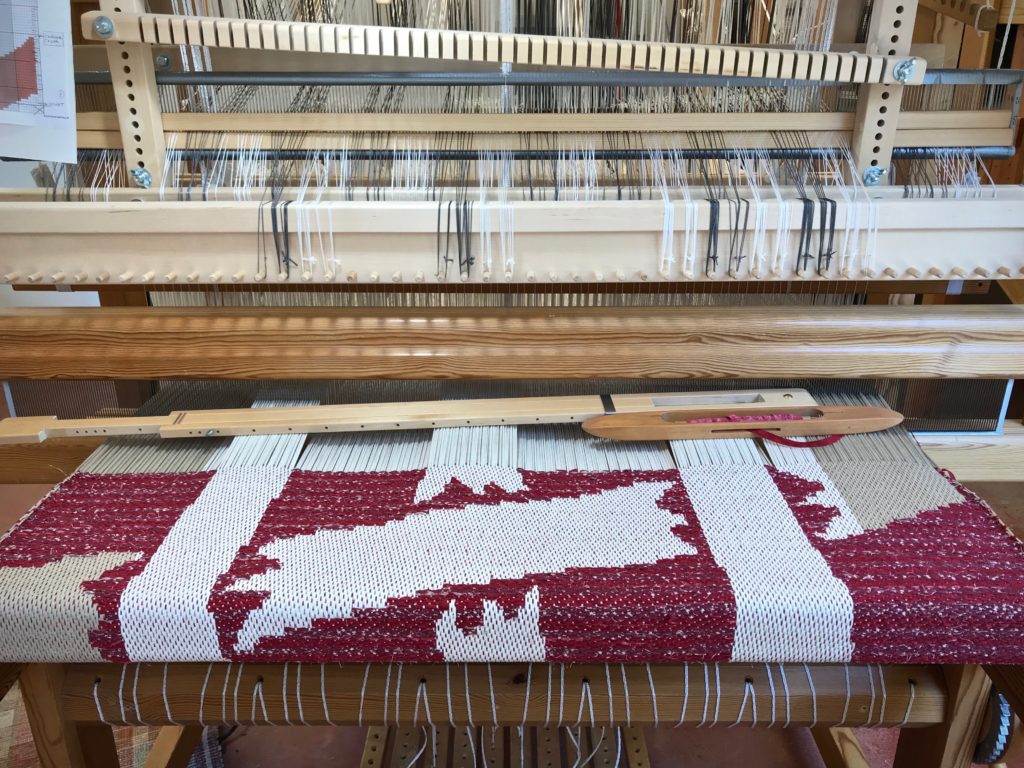The chart that hangs at the left side of the beater gives a glimpse of the overall design of this rag rug. It’s the second page of a three-page chart. It’s not easy to make sense of the design on the loom, seeing only a small slice of the big picture. I am eager to see the whole project woven, to see how it aligns with the design I’ve imagined.


I drew the design in MacStitch, a cross-stitch design program. Then, I imported the gridded image into Photo Affinity to add vertical shaded stripes to match the 10 white-/10 black-cord arrangement of single-unit draw cords on the loom. Lastly, I printed the enlarged chart to use as my guide at the loom.

How does our present slice of life fit into the overall plan? Only God knows. But one thing is certain. The Grand Weaver has a purpose for your life. It’s a purpose that he will fulfill. You and I are the work of his hands, work that he will not abandon. Yes, we make our plans. The truth is, our best plan is that which aligns with the design he has imagined.
May you get a glimpse of your life’s design.
On purpose,
Karen

Oh my goodness!!!
Just when I think I’ve seen it all, there is more. God is great!
How are you getting such even widths on your rag warps?
Kind regards,
Nannette
Hi Nannette, I like the way you notice detail.
I’m not sure if you’re asking about the rag wefts, or about the width of the warp overall…
For the rag wefts –
I fold the fabric yardage and put it on my cutting mat. I use a clear quilting ruler to measure off 1 cm (3/8”), and slice it off with my large-blade rotary cutter. It takes a lot of cutting for a rug this size with strips this thin. I usually cut 40 strips, then weave them, then cut 40 more, then weave them, and so on.
For the width of the warp –
I use a temple, and I bubble the weft. Both factors help keep the warp width uniform size.
Thanks for asking,
Karen
Curious about the 3/8″ strips. It appears you are using only one strip at a time so the front and back will be different colors. Is that correct?
What set are you using? Wondering how thick it will be when finished.
Hi Linda, I am using only one fabric strip at a time. The back is the reverse of the front. In other words, where you see the red on front, you will see the predominant warp threads on the back, and vice versa.
The sett is 7 doubled ends per centimeter (I think that’s about 18 doubled ends per inch), which makes the warp very dense. The first rug from this warp is about the same thickness as my “regular” rag rugs, but I would say the rug is stiffer and feels more densely packed.
Thanks for asking,
Karen
I look forward to seeing the completed rug. This is a very interesting desigtn.
Hi Joanne, It will be gratifying to see the whole rug at once. I tried to come up with a design that is simple enough to work with the scale of this rug.
Thank you,
Karen
Fascinated by the drawloom. Could I contact you to talk more about it?
Hi Linda, Absolutely, you can contact me any time! The best way to reach me is through this contact form: Get in Touch.
I look forward to hearing from you,
Karen
That’s impressive, and the design is quite dramatic. Now I am curious to see it finished 🙂
I like the possibilities a draw loom offers, but I am afraid it would be too complex for me.
It is a challenge to be content with only seeing today, but to be able to focus on the present day and the task at hand, that’s where I find the beauty of life
Hi Elisabeth, It helps to know one’s purpose. The drawloom isn’t for everyone. But when you come out to see me, I’d like to give you a swing at mine. 🙂
I agree with you, that it is so important to focus on the present day we have–a gift that’s been given to us.
Happy weaving,
Karen
It looks really interesting. It’s so good to see a rug being woven using the drawloom. It shows that it can be a very versatile loom. I like your work!
Hi Anna, I am touched by your words of affirmation. Thank you!
I have always been interested in rag rug weaving, so when I got a drawloom, I knew this was something I wanted to try. Yes, indeed, this is a very versatile loom. I will never run out of things to learn and try on it.
Happy Weaving,
Karen
Beautiful work. I’m really new to draw loom and have a question from the photo. Are you using a shaft and individual draw on your loom. The shafts being pulled and on the pegs below the draw attachment. In the photo, right now, there are no individual warp ends selected. Am I interpreting the photo correctly. Thank you, looking forward to seeing the finished rug.
Hi LJ, You are asking pertinent questions. I do have the Myrehed combination draw frame; however, this project is not using the shaft draw system at all. This is completely woven with the single unit draw. In the second picture you can see the shaft draw handles near the top of the draw frame. They are not being used on this project. The single unit draw cords are the black cords and white cords that you see, some of which are pulled and held in place by the pegs on the hook bar. In other words, these draw cords that are pulled are lifting individual units of threads. Whereas, if any of the shaft draw handles were pulled, they would be lifting pattern shafts holding certain units of threads.
Does that clarify?
My next “death-defying feat” will be to use the combination–both shaft draw and single-unit draw on the same project. I’m still wrapping my mind about how that will work. Coming soon…!
Thank you!
Karen
It does. I have a shaft draw system that I’ve only used a couple of times and so interested in learning it’s possibilities. Thank you for the great explanation.
We’re both learning the possibilities of a drawloom. It’s pretty amazing.
Karen
Super neat!
Hi Loyanne, Thanks! I guess you can see I’m having a great time. 🙂
Happy weaving,
Karen
Karen, this rug is so pretty. I can hardly wait to see it when it is finished.
Hi Martha, I’m glad you like it! It’s a fascinating project to work on. Like you, I am eager to see it rolled out.
Thanks so much!
Karen